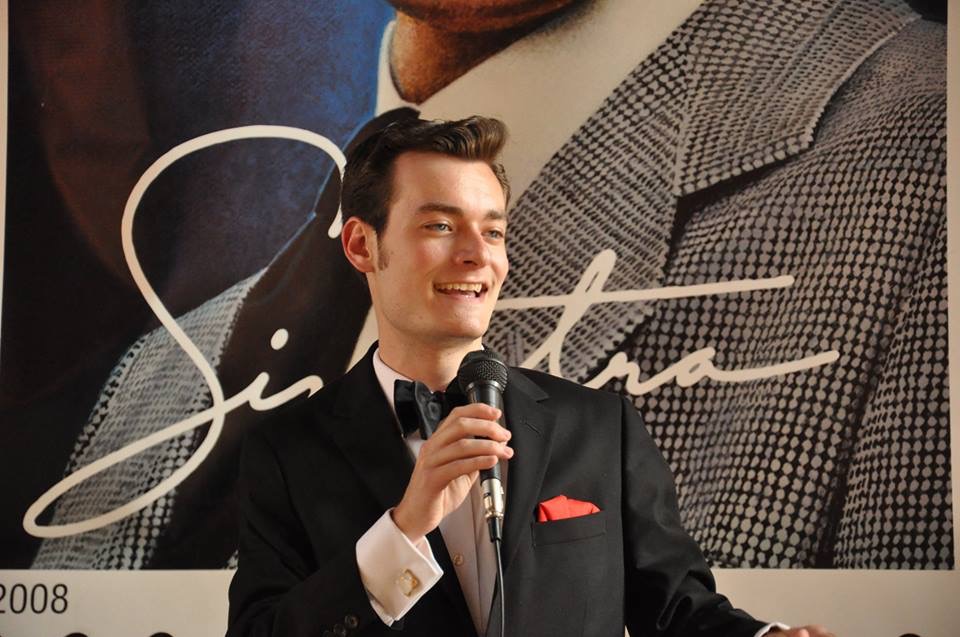 Hoboken Historical Museum to Open Year-Long Exhibition,
Hoboken Historical Museum to Open Year-Long Exhibition,
“Frank Sinatra: The Man, the Voice & the Fans,” with a
Free Reception & Vocal Performance on August 2, 2015
Honoring the 100th anniversary of the birth of Hoboken's most famous native son, the Hoboken Historical Museum, 1301 Hudson St., will open a new exhibition, "Frank Sinatra: The Man, the Voice, & the Fans," on Sunday, Aug. 2, with a free opening reception from 2 - 5 p.m. At 4 p.m., a live performance by Zack Alexander will kick off the “First Sundays Sinatra Singers” series, featuring a different crooner each month at 4 pm.
The exhibition will feature interactive displays and videos, cherished fan photographs and artifacts to illustrate the singer/actor's formative years in Hoboken, and memories from long-time fans. Listening stations will be supplied by period-appropriate music players, from old radio sets and vinyl record players, to 8-track tape players, audio-cassette boomboxes and CD players, reflecting the remarkable span of his 60-year career.
The exhibition will remain on view through July 3, 2016, accompanied by related programming, including “First Sundays Sinatra Singers,” with support from the Hoboken Department of Cultural Affairs; “Second Tuesdays Sinatra Films,” with support from Projected Images of Hudson County; readings by noted authors; plus a big birthday bash on Dec. 12, 2015. Also on December 12, the Museum will unveil a new bronze star plaque honoring Sinatra’s centennial, to be installed in the walkway by the Museum’s entrance at 13th and Hudson Sts. Event details will be posted at hobokenmuseum.org.
Sinatra was, as writer Bruce Bliven put it, "a kid from Hoboken who got the breaks." He emerged from a blue-collar, working class, urban setting, where most guys, he once told an audience, became fighters or worked in factories. His own father, Martin, who immigrated from Sicily, started out as a boxer, fighting under the assumed name of Marty O'Brien to gain access to Irish-controlled gyms that wouldn't admit Italians. His mother worked as well, as a midwife and also as a liaison for the largely Italian neighborhood to the city’s political bosses.
 The exhibition will shed light on how growing up in early 20th century Hoboken shaped the young singer. Although he was born in a cold-water flat in a neighborhood of newly arrived immigrants in Southwest Hoboken, his early years weren't as rough as some biographers have portrayed. He was a rare only child, doted on by his mother, Dolly, who used her political savvy and gift for languages to improve her family's station, eventually securing Marty a position with the city's fire department when he could no longer fight professionally. By the time young Frank was 12, the Sinatras had moved to better housing in a more established neighborhood and he earned the nickname of "Slacksy O'Brien" for the dress pants he sported. In the 1920s and 30s, he was one of many aspiring young singers who performed on Hoboken’s street corners, in pool halls and clubs, and in private homes—wherever they could get an audience.
The exhibition will shed light on how growing up in early 20th century Hoboken shaped the young singer. Although he was born in a cold-water flat in a neighborhood of newly arrived immigrants in Southwest Hoboken, his early years weren't as rough as some biographers have portrayed. He was a rare only child, doted on by his mother, Dolly, who used her political savvy and gift for languages to improve her family's station, eventually securing Marty a position with the city's fire department when he could no longer fight professionally. By the time young Frank was 12, the Sinatras had moved to better housing in a more established neighborhood and he earned the nickname of "Slacksy O'Brien" for the dress pants he sported. In the 1920s and 30s, he was one of many aspiring young singers who performed on Hoboken’s street corners, in pool halls and clubs, and in private homes—wherever they could get an audience.
Sinatra’s big break came in 1935, when a Hoboken trio calling themselves the Three Flashes invited him to join them for a shot at the “American Idol” of its day, the radio program "Major Bowes and His Original Amateur Hour". The Hoboken Four were a hit, and toured with other acts from the program for the next several months. Sinatra soon went solo, performing at the Rustic Cabin in Englewood, NJ, which was broadcast on WNEW's radio program, Dance Parade, leading to an invitation to join the Harry James band. In 1939, he joined Tommy Dorsey’s band and became a sensation, earning the name "Swoonatra," for causing teenage girls to faint at his concerts.
He would go on to sell more records than any previous singer, and to pursue a successful Hollywood film career, including an Oscar-winning performance in "From Here to Eternity." He and his pals in the "Rat Pack" defined the image of American cool in the 1950s and 60s. He survived personal and professional setbacks, as well as changes in musical tastes, and continued to tour and record successful records into his later years. When he died in 1998, fans swarmed Hoboken to mourn the man whose music and movies had meant so much to them. The same year, the Museum created a “Sinatra Walking Tour Map,” which is being updated for the new exhibit for fans who wish to walk in his footsteps. Learn more at hobokenmuseum.org.
